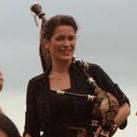 Silk Road Ensemble and Music 194 team up for Performing Musical Difference, an ARTS FIRST concert that celebrates the rhythms of unity.
Silk Road Ensemble and Music 194 team up for Performing Musical Difference, an ARTS FIRST concert that celebrates the rhythms of unity.
By Sasha Barish '20
Music 194: Performing Musical Difference is a unique course at Harvard. Professor of music Kay Shelemay teaches the class along with members of the Silk Road Ensemble, and their students have spent the semester engaged in both the academic study and the performance of music that crosses cultural boundaries. At this year’s ARTS FIRST festival, they will present Performing 
Performing Musical Difference comes out of Harvard’s relationship with the Silk Road Ensemble. Founded by Yo-Yo Ma ’67 and named for the historical trade network that connected and spanned so many peoples, the ensemble aims to connect people by making cross-cultural music. Members of the Silk Road Ensemble have been regularly doing term-time and summer projects at Harvard for over a decade in addition to the group’s other performances. Shelemay has designed the course over the past two years in collaboration with members of the ensemble, especially global percussionist Shane Shanahan and Galician bagpiper Cristina Pato, who are currently Blodgett Visiting Artists at Harvard.
Harvard has provided indispensible funding for the course through various grants and through its dedication to music.
“More and more we’ve begun to incorporate performance into our teaching,” said Shelemay. “All

This unity of performance and scholarship is embodied well in Music 194. The students have both played the pieces with the mentorship of the Silk Road Ensemble and written program notes for an upcoming open-source website with information about Silk Road pieces.
The feeling of the course is unlike most other courses in the university. The students are a crew of a couple dozen drawn from Harvard College, GSAS, the Extension School and the Cambridge community.
“Someone’s bringing their child or grandchild [to class] tomorrow,” said Shelemay. “We’ve had people bring their mothers. It’s really quite a lively community. We also have visitors; tomorrow we have a visitor, a young woman who’s collaborating with Silk Road who has done a lot of music-based social engagement, [including] projects with the Boston police department, and [other] compositions in the area.”
At the ARTS FIRST performance, the first of the three pieces will be directed by Shanahan and played by almost all the students.
“Shane has been working with the class on body percussion, drawing on traditions from the Middle East and from India and from Africa in different aspects of the performance,” Shelemay said. “It’s a rather improvisatory piece, and it’s an extraordinary piece, with stomping and clapping and body percussion, and vocal parts – they use the drum mnemonics, the drum syllables that are part of the tradition in India and a number of other places.”
The second piece is an improvisatory duet played by two graduate students in music, with a melody on the kamancheh, the Persian bowed lute, and an accompaniment on the mridangam, a Carnatic Indian hand drum.
The final piece Wedding was written by Kinan Azmeh, a Syrian clarinetist and member of the Silk Road Ensemble, and was part of the Silk Road album Sing Me Home, which recently won a Grammy Award. It is based on a melody with which Azmeh was familiar and can be played with various instruments.
Shelemay herself is an ethnomusicologist and Africanist. Her recent work has focused on Ethiopia, and she is working on a book about immigrants from the Horn of Africa to the U.S.
But Shelemay said her scope is more universal.
“I’m very interested in the role that music plays in forced migration,” she told me. “Folks in the Silk Road ensemble have experienced forced migration; there is a member from Syria, there is a Persian musician and there are others. I’ve always enjoyed the Silk Road because of their sensitivity to cross-cultural difference and because of the way in which they incorporate people who have experienced different worlds, often originally under forced measure.”
“How does that interaction of cultures affect the music?” I asked Shelemay. “If someone goes to this concert, what might they listen to and think about?”
“Well, they should think about the process of making music,” she said, “which isn’t necessarily to have a fixed composition. Now the percussion piece we’re doing is kind of a hybrid piece, a real mixture of different percussion styles. And a lot of music today is quite hybrid. There was a wonderful composer named Lou Harrison who said that in fact most music is comprised of a lot of different influences, just that these days it tends to be more global and a lot more marked; you can actually hear the differences as they come together.”